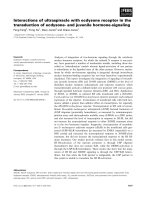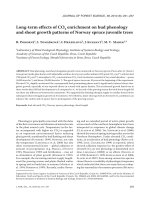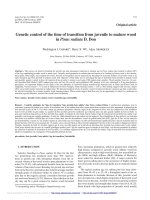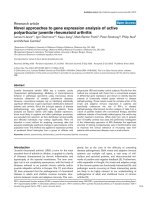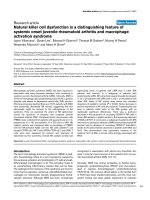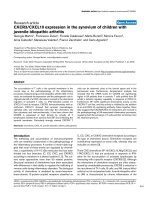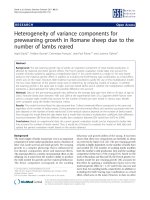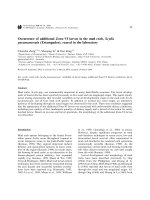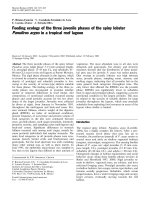Growout of hatchery reared juvenile babylonia
Bạn đang xem bản rút gọn của tài liệu. Xem và tải ngay bản đầy đủ của tài liệu tại đây (166.07 KB, 2 trang )
Aquaculture International (2005) 13: 233–239
DOI 10.1007/s10499-004-1585-8
Ó Springer 2005
-1
Growout of hatchery-reared juvenile spotted babylon
(Babylonia areolate link 1807) to marketable size
at four stocking densities in flow-through and
recirculating seawater systems
N. CHAITANAWISUTI1,*, S. KRITSANAPUNTU2 and
S. Y. NATSUKARI3
1
Aquatic Resources Research Institute, Chulalongkorn University, Phya Thai Road, Pathumwan,
Bangkok 10330, Thailand; 2Department of Bioproduction, Faculty of Technology and Management,
Prince of Songkla University, Suratani Province 84100, Thailand; 3Faculty of Fisheries, Nagasaki
University, 1–14 Bunkyo-Machi, Nagasaki 852, Japan; *Author for correspondence (e-mail:
)
Received 22 December 2003; accepted in revised form 21 July 2004
Key words: Spotted babylon, Babylonia Areolata, Growout, Stocking density, Flow-through water
system, Recirculating water system
Abstract. Hatchery reared juvenile spotted babylon, Babylonia areolata, were raised in canvas
rearing tanks at four stocking densities (100, 200, 300 and 400 ind. mÀ2) in flow-through and
recirculating seawater systems until they reached the marketable sizes of 100–140 snails/kg. At all
stocking densities, final increments in mean length and weight of snails held in flow-through
systems were higher than those in recirculating systems, there was a significant effect (p < 0.05) of
culture system on final length and weight. Mean (±SE) survival of snails held at 100 ind. mÀ2 in
the flow-through system was 100.0 ± 0.1% but was not significantly higher than survival in any
other treatment (p > 0.05). Mean survival of snails held in the recirculating system was not significantly lower than at any stocking density in the flow-through system (p > 0.05).
Introduction
The spotted babylon, Babylonia areolata, supports the second largest commercial gastropod fishery in Thailand. In recent years there has been a rapid
increase in market demand for this species in Thailand and other Asian
countries. Because of this economic importance and the success with babylon
culture, interest has developed in developing appropriate culture systems to
increase per unit production (no.mÀ2), as well as decrease maintenance time
and production costs during the growout phase of culture. Although large scale
rearing of B. areolata is technically feasible, many problems must be solved to
enable economically viable spotted babylon culture to develop. One problem
that must be solved during growout in both intensive and extensive culture is
stocking density, particularly with respect to growth. Effects of stocking density on growth and survival are well documented for some marine bivalves and
gastropods, e.g. oysters (Holiday et al. 1993), clams (Hadley and Manzi 1984),
queen conch (Appeldoorn and Sanders 1984; Siddall 1984) and abalone
234
(Mgaya and Mercer 1995). The type of system used to culture spotted babylon
influences growth, survival and cost of production (Chaitanawisuti and
Kritsanapuntu 2000), but there was no information available on optimal
stocking density for large scale production of juveniles of this species. In the
present study the relationship between stocking density, growth and survival
was determined for growout of hatchery reared juveniles of the spotted
babylon in flow-through and recirculating seawater systems.
Materials and methods
Design of experimental culture systems
Four treatments of each culture system, each with two replicates were used as
follows.
Flow-through system
Juveniles were reared in indoor rectangular canvas tanks that measured
1.5 · 0.5 · 0.7 m (L:W:H). Each tank was supplied with flow-through ambient
natural seawater at a rate of 50 l hÀ1 . Water depth was maintained at 0.5 m.
The bottom of each tank was covered with a 5 cm layer of coarse sand (0.5–
1.0 mm mean grain size) that served as a substrate. When snails were removed
from the rearing tanks for measurement, the substrate was cleaned by flushing
it with a jet of water and sun dried for 6 h every 30 days. Salinity and temperature ranged from 29 to 30 ppt and 29–32 °C respectively.
Recirculating system
Each canvas tanks measured 1.5 · 0.5 · 0.7 m (L:W:H) and had an independent recirculating system with supplemental aeration, airlift pump and biological filter. Biological filters were tanks of 0.5 · 5 · 0.7 m (L:W:H) that
contained oyster shells held in nylon net bags. Water flowed from the culture
tank through the filters via airlift pumps at a flow rate of 100 l hÀ1, before it
was returned to the rearing tank. As in the flow-through system, the tank
bottom was covered with a 5 cm layer of coarse sand (0.5–1.0 mean grain size)
to serve as a substrate. When snails were removed from the tank for measurement, the substrate was cleaned by flushing it with a jet of water and sun
dried for 6 h every 30 days. The tank was then refilled with ambient seawater.
Filter bags were rinsed in seawater to remove particulate matter, sun dried for
6 h and returned to the filter tank. Salinity was maintained at 29–30 ppt by
addition of fresh water to correct for any increased salinity due to evaporation.
Juvenile rearing
Juvenile spotted babylons used in growth and survival experiments were produced in a hatchery (Chaitanawisuti and Kritsanapuntu 1997a). Individuals
